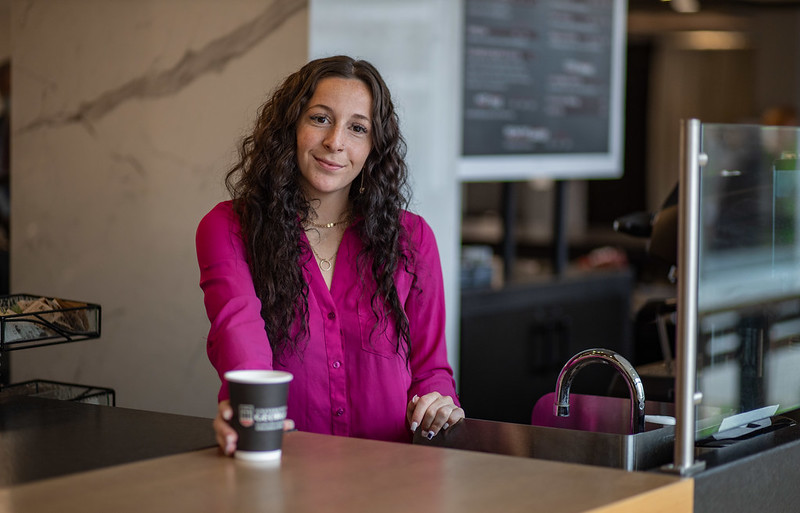After nearly 16 months, COVID-19 -related restrictions are lifting across the nation, breathing life back into the hospitality industry as people return to dining out at restaurants and traveling for both business and pleasure.
In an industry hard-hit by the pandemic — employment in the industry is down by 2.8 million, or 16.8%, since February 2020, according to the U.S. Bureau for Labor Statistics — this return to normal is a welcome trend, however many businesses are struggling to fill essential positions to handle the increasing capacity.
“We’ve been hearing a lot in the general media that operators believe it is the stimulus funding, combined with unemployment benefits, keeping people at home, but that is a simplistic way of looking at the situation,” said John Salazar, associate professor and coordinator of the Hospitality and Food Industry Management program in the College of Agricultural and Environmental Sciences at the University of Georgia. “It is a lot more complex than that and, while it is gaining a lot of attention, there is much more to the situation. There are a lot of layers here.”
While the worldwide impact of the COVID-19 crisis is beyond anything he has experienced before, Salazar is confident that the industry will recover, if slowly.
According to the American Hotel and Lodging Association 2021 State of the Hotel Industry report, the hotel industry experienced the most devastating year on record in 2020, resulting in historically low occupancy, massive job loss and hotel closures across the country after travel was forced to a virtual halt in early 2020. Travel is not expected to return to 2019 levels until 2024.
Salazar projects that improvement will come in fits and spurts until things eventually get back to normal. And while much attention has been given to increasing wages for service workers, pay is only a small part of the issue.
“When the pandemic started and businesses shuttered, a lot of employees in the hospitality industry were sidelined. Many of those people could not wait for things to recover to return to the industry, so many of those people found employment in other sectors,” Salazar explained.
While the hospitality industry saw declines, industries like electronic retail, technology and health care boomed during the pandemic.
“For example, the operations of the supply chain in the hotel industry are very similar to the operations of the supply chain in hospitals — they have the same laundry concerns, they have the same housekeeping concerns — and as the pandemic started to drag on, a segment of the population of workers found employment in other industries. Many others just couldn’t wait to see when the restaurant or hotel they really loved working at was going to open up again. They ended up finding another sector to go to.”
Other workers are reluctant to return to the public-facing nature of many hospitality jobs due to fear of contracting COVID-19 because of inconsistent mask policies and relatively low vaccination numbers among the public.
“There is still this sustained fear of getting COVID in the workplace, even though vaccines are being distributed. That fear is related to other underlying paradigms in play, such as inconsistent mask-wearing policies,” he added. “Larger, branded organizations have much stronger footing to require guests and visitors to wear masks. It is harder for a small operator to do that because they are living on much thinner margin. These inconsistent mask policies, combined with public reluctance to getting the vaccine, have employees concerned about their own wellbeing.”
Other concerns keeping workers away involve remote learning and childcare availability for young children. Many workers have been reluctant or unable to send their children to school or daycare during systemwide changes and closures, and many after-school programs and activities that cover shift hours were suspended during the pandemic. For some, caring for elderly relatives has presented similar challenges.
Despite the hit to the industry, the university’s Hospitality and Food Industry Management program has grown exponentially over the past year, meeting its three-year enrollment goals in less than two years.
For students in the program, the surplus of available jobs has led to internship and job opportunities that may not have been available to students or new graduates before. According to the U.S. Bureau of Labor Statistics, employment in leisure and hospitality increased by 331,000 in April as pandemic-related restrictions continued to ease in many parts of the country. More than half of the increase was in the food services and bar industry, with more than 187,000 jobs added. Job gains also occurred in amusements, gambling and recreation, which added more than 73,000 jobs, and in accommodations, with a gain of more than 54,000 jobs.
“The industry has been reaching out to our hospitality program quite purposefully in trying to get in front of UGA students for hiring,” Salazar said. “We have a group of students going out into the internship world in a market segment that is in dire need of help. They are going to positions at Callaway Gardens and Chateau Elan and The DeSoto Hotel in Savannah. The market that is reaching out to our students is catering to an income bracket that can afford to travel and our students have been welcomed by a market segment that is so enthusiastic to have them.”
Since entering the hospitality industry 25 years ago, Salazar said he has seen the industry weather crises including the Transportation Security Administration restrictions put in place after the September 11 attacks in 2001 and the financial recession in 2008.
While it may take time for things to return to a new state of normal, Salazar is encouraged by the adaptability of the industry.
“The things that had to change or be adopted within the industry during the COVID pandemic have increased the use of technology, created a more focused paradigm on cleanliness, and even improved ways of increasing the quality of food that is delivered. Some of these busines components that had to be adopted during COVID are going to remain in the post-COVID world and be a permanent part of the industry,” he said.
The enthusiasm of students in the Hospitality and Food Industry Management program has remained high, he added.
“One thing I have learned is that our hospitality students are still motivated and goal-driven and passionate. Our HFIM majors continue to remain steadfast to their aspirations,” Salazar said. “They shifted to embrace the pandemic by teaching themselves new skills such as virtual event planning and enrolling in minors and certificate programs that would enhance their employability after graduation such as nutrition, entrepreneurship and sustainability. They are very enthusiastic, and it really has been quite exciting to witness. We still have people who love this business and a generation who have a lot to offer and who will be welcomed.”
Recently, HFIM faculty partnered with the UGA Center for Agribusiness and Economic Development to collect, analyze and interpret hospitality and travel economic data for all 159 Georgia counties for 2019. Hospitality and Travel Economic Snapshots for Georgia Counties is an interactive infogram that shows data for the hotel and restaurant sector, as well as domestic travel spending and tax revenue information. The infogram provides hotel and restaurant sales/revenues, the number of jobs and the amount of income generated from those sectors and will be updated annually.
For more information on the HFIM program, visit the website.





.jpg)


